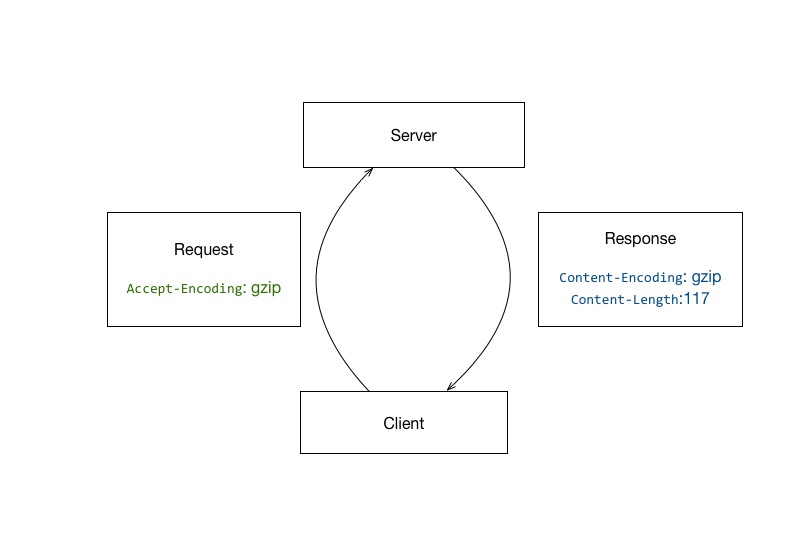聊聊HTTP gzip压缩与常见的Android网络框架
进入主题之前,我们先来看一下客户端与服务器通信过程中,如果服务器支持,HTTP gzip压缩是如何实现的?
如图所示:

request header中声明Accept-Encoding: gzip,告知服务器客户端接受gzip的数据。
服务器支持的情况下,返回gzip后的response body,同时加入以下header:
Content-Encoding: gzip:表明body是gzip过的数据Content-Length:117:表示body gzip压缩后的数据大小,便于客户端使用。
或
Transfer-Encoding: chunked:分块传输编码
OK,HTTP gzip压缩的基本流程我们理清楚了,来看在Android各网络框架中表现有什么差异。
OkHttp
OkHttp作为目前Android最火的网络库,应用范围较广,相比于Android自带的HttpUrlConnection、Apache坑也少很多。
我们首先来看这个库的实现:
(注:以下代码基于OkHttp 3.4.1, 之前的版本逻辑也是一样的,但3.4.0开始将这些逻辑抽离到了内置的interceptor中,看起来较为方便)
// If we add an "Accept-Encoding: gzip" header field we're responsible for also decompressing
// the transfer stream.
boolean transparentGzip = false;
if (userRequest.header("Accept-Encoding") == null) {
transparentGzip = true;
requestBuilder.header("Accept-Encoding", "gzip");
}
如果header中没有Accept-Encoding,默认自动添加 ,且标记变量transparentGzip为true。
if (transparentGzip
&& "gzip".equalsIgnoreCase(networkResponse.header("Content-Encoding"))
&& HttpHeaders.hasBody(networkResponse)) {
GzipSource responseBody = new GzipSource(networkResponse.body().source());
Headers strippedHeaders = networkResponse.headers().newBuilder()
.removeAll("Content-Encoding")
.removeAll("Content-Length")
.build();
responseBuilder.headers(strippedHeaders);
responseBuilder.body(new RealResponseBody(strippedHeaders, Okio.buffer(responseBody)));
}
针对返回结果,如果同时满足以下三个条件:
transparentGzip为true,即之前自动添加了Accept-Encoding- header中标明了
Content-Encoding为gzip - 有body
移除 Content-Encoding、Content-Length,并对结果进行解压缩。
可以看到以上逻辑完成了:
- 开发者没有添加
Accept-Encoding时,自动添加Accept-Encoding: gzip - 自动添加的request,response支持自动解压
- 手动添加不负责解压缩
- 自动解压时移除
Content-Length,所以上层Java代码想要contentLength时为-1 - 自动解压时移除
Content-Encoding - 自动解压时,如果是分块传输编码,
Transfer-Encoding: chunked不受影响。
以上6点是我们通过OkHttp源码得出的结论,我们以此来继续看下其他框架。
HttpUrlConnection
1. 是否自动添加Accept-Encoding: gzip
官网有过说明:
In Gingerbread, we added transparent response compression. HttpURLConnection will automatically add this header to outgoing requests, and handle the corresponding response:
Accept-Encoding: gzip
Take advantage of this by configuring your Web server to compress responses for clients that can support it. If response compression is problematic, the class documentation shows how to disable it.
即:2.3后默认是gzip,不加Accept-Encoding会被自动添加上Accept-Encoding: gzip。
2. 自动添加的request,response是否支持自动解压
By default, this implementation of HttpURLConnection requests that servers use gzip compression and it automatically decompresses the data for callers of getInputStream().
即返回的数据是已经自动解压缩的。
3. 手动添加是否负责解压缩
By default, this implementation of HttpURLConnection requests that servers use gzip compression and it automatically decompresses the data for callers of getInputStream(). The Content-Encoding and Content-Length response headers are cleared in this case. Gzip compression can be disabled by setting the acceptable encodings in the request header:
urlConnection.setRequestProperty("Accept-Encoding", "identity");
Setting the Accept-Encoding request header explicitly disables automatic decompression and leaves the response headers intact; callers must handle decompression as needed, according to the Content-Encoding header of the response.
例子中只提到设置为identity时可以禁止gzip压缩。
但是请注意最后一段提到,显式声明会禁止自动解压,同时保留header完整性,需要根据Content-Encoding来自己处理response。
实测4.1 - 6.0 版本之后发现,并不是非要指定identity才能屏蔽,指定gzip一样也不会解压缩。so,只要是显式声明过,都不会再处理,即:手动添加不会负责解压缩。
4. 自动解压时Content-Length问题
Since HTTP’s Content-Length header returns the compressed size, it is an error to use getContentLength() to size buffers for the uncompressed data. Instead, read bytes from the response until InputStream.read() returns -1.
即:getContentLength() 值为gzip压缩时的数据大小。
之前提到OkHttp在处理gzip压缩时会把Content-Length移除,contentLength在Java层获取为-1,而HttpURLConnection 在Android 4.4以后底层是由OkHttp实现的,那文档中提到的getContentLength()是compressed size是否还继续成立呢?
实测后发现 :
- 4.4之后的版本,
Content-Length被移除,getContentLength()= -1 - 2.3- 4.3之间,
Content-Length没有移除,getContentLength()= compressed size
5. 自动解压时的Content-Encoding
与Content-Length对应:
- 4.4之后的版本,
Content-Encoding被移除 - 2.3- 4.3之间,
Content-Encoding存在,无变化。
6. 自动解压时的分块编码传输
与OkHttp相同,Transfer-Encoding: chunked不受影响。
Apache
这里不再赘述,仅阐述结论:
无自动添加、解压机制。
总结
1、是否支持自动添加Accept-Encoding与数据自动解压?
| name | transparent response compression |
|---|---|
| OkHttp | yes |
| HttpUrlConnection | yes |
| Apache | no |
2、支持自动后,response header的表现如何?
| name | Content-Encoding: gzip | Header : Content-Length | Java : ContentLength |
|---|---|---|---|
| OkHttp | 被移除 | 被移除 | -1 |
| HttpUrlConnection(2.3 ~ 4.3) | 不变 | 不变 | compressed size |
| HttpUrlConnection(4.4 ~ ?) | 被移除 | 被移除 | -1 |
或
| name | Content-Encoding: gzip | Transfer-Encoding: chunked |
|---|---|---|
| OkHttp | 被移除 | 不变 |
| HttpUrlConnection(2.3 ~ 4.3) | 不变 | 不变 |
| HttpUrlConnection(4.4 ~ ?) | 被移除 | 不变 |
3、自动模式启动后,在Java中获取contentLength无论是哪个版本的HttpUrlConnection还是OkHttp都是不可信的,都不是解压缩之后的值(可能为-1或compressed size),因此最好不要通过contentLength来做什么操作。
4、HttpUrlConnection、OkHttp均是手动添加不自动解压缩,Apache没有自动添加自动解压功能。三者在手动添加Accept-Encoding后,表现一致(利用这个特点,可以做一个在三者之上的网络框架,随意切换三种通道)。
参考资料
聊聊HTTP gzip压缩与常见的Android网络框架的更多相关文章
- Android网络框架Volley(体验篇)
Volley是Google I/O 2013推出的网络通信库,在volley推出之前我们一般会选择比较成熟的第三方网络通信库,如: android-async-http retrofit okhttp ...
- Android网络框架Volley
Volley是Google I/O 2013推出的网络通信库,在volley推出之前我们一般会选择比较成熟的第三方网络通信库,如: android-async-http retrofit okhttp ...
- Android网络框架Volley(实战篇)
之前讲了ym—— Android网络框架Volley(体验篇),大家应该了解了volley的使用,接下来我们要看看如何把volley使用到实战项目里面,我们先考虑下一些问题: 从上一篇来看 mQu ...
- Android网络框架-Volley实践 使用Volley打造自己定义ListView
这篇文章翻译自Ravi Tamada博客中的Android Custom ListView with Image and Text using Volley 终于效果 这个ListView呈现了一些影 ...
- ym—— Android网络框架Volley(终极篇)
转载请注明本文出自Cym的博客(http://blog.csdn.net/cym492224103).谢谢支持! 没看使用过Volley的同学能够,先看看Android网络框架Volley(体验篇)和 ...
- 几种常见的Android自动化测试框架及其应用
随着Android应用得越来越广,越来越多的公司推出了自己移动应用测试平台.例如,百度的MTC.东软易测云.Testin云测试平台…….由于自己所在项目组就是做终端测试工具的,故抽空了解了下几种常见的 ...
- Android网络框架技术
网络相关1. Asynchronous Http Client for Android Android异步Http请求项目地址:https://github.com/loopj/android-asy ...
- Android网络框架OkHttp之get请求(源码初识)
概括 OkHttp现在很火呀.于是上个星期就一直在学习OkHttp框架,虽然说起来已经有点晚上手了,貌似是2013年就推出了.但是现在它版本更加稳定了呀.这不,说着说着,OkHttp3.3版本在这几天 ...
- Android网络框架源码分析一---Volley
转载自 http://www.jianshu.com/p/9e17727f31a1?utm_campaign=maleskine&utm_content=note&utm_medium ...
随机推荐
- 多个git使用的 ssh key共存
ssh-keygen -t rsa -C "ljkj028@qq.com" 不要一直回车,指定密钥为 id_rsa_ljkj 默认为(id_rsa) 同理 创建其他密钥 打开ssh ...
- Jmeter HTTP请求后响应数据显示乱码解决方法
Jmeter请求后结果树里无论是text还是html响应数据显示乱码,这是因为jmeter 编码格式配置文件默认不开启导致的,解决方法如下: 1)进入jmeter-***\bin目录下,找到jmete ...
- 机器学习技法笔记:01 Linear Support Vector Machine
Roadmap Course Introduction Large-Margin Separating Hyperplane Standard Large-Margin Problem Support ...
- mysql常用function
前言: 本文主要是参考mysql官方文档,并加上自己的测试用例,来加深自己对mysql函数的理解,也借此平台与大家分享,如有不妥和错误之处欢迎读者评论,我会及时改正,愿与大家一起学习进步. 概述: 所 ...
- Liferay的一些应用领域
Liferay的用途是快速的部署内外站点,统一权限管理,开发Web热插拔插件,并不是所有系统都适合 不适合Liferay的一些应用领域: 1.独立认证.简单的系统,比如一些简单的增删改查:2.复杂业务 ...
- iOS-SVProgressHUDMaskType
SVProgressHUDMaskTypeNone:默认图层样式,当HUD显示的时候,允许用户交互. SVProgressHUDMaskTypeClear:当HUD显示的时候,不允许用户交互. ...
- apache和tomcat的区别和联系
两者既有联系又有区别,是两个软件,可独立使用,也可整合使用.Apache是web服务器(静态解析,如HTML),本身只支持html,Web服务器专门处理HTTP请求(request),可以通过插件支持 ...
- Linux学习笔记之五————Linux常用命令之用户、权限管理
一.引言 用户是Unix/Linux系统工作中重要的一环,用户管理包括用户与组账号的管理. 在Unix/Linux系统中,不论是由本机或是远程登录系统,每个系统都必须拥有一个账号,并且对于不同的系统资 ...
- 从零开始学 Web 之 ES6(六)ES6基础语法四
大家好,这里是「 从零开始学 Web 系列教程 」,并在下列地址同步更新...... github:https://github.com/Daotin/Web 微信公众号:Web前端之巅 博客园:ht ...
- zmq setsockopt()
zmq.RCVTIMEO:在一个recv操作返回EAGAIN错误前的最大时间 设置socket的接收操作超时时间.如果属性值是0,zmq_recv(3)函数将会立刻返回,如果没有接收到任何消息,将会返 ...
